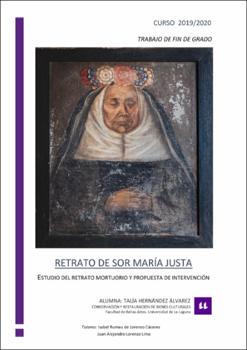Retrato de Sor María Justa: Estudio del retrato mortuorio y propuesta de intervención
Author
Hernández Álvarez, TaliaDate
2020Abstract
El ser humano, desde la Antigüedad, ha sentido siempre la necesidad de dejar constancia
de su paso por la vida. El método en que hacerlo ha variado con el paso del tiempo, empleando
diferentes técnicas para ello antes de la aparición de la fotografía y otros medios actuales.
El presente Trabajo de Fin de Grado tiene como objetivo dar a conocer una de estas
técnicas: el retrato mortuorio, y la distinción de sus distintos tipos. Se hará un recorrido histórico
y artístico de este para posteriormente centrarlo en Canarias, nombrando varios autores y obras
representativas del género. Pero principalmente se centrará sobre una obra: el retrato funerario de
Sor María Justa, monja del ex convento de San José de La Orotava. Dicha obra se investigará
detenidamente para posteriormente determinar su estado de conservación. Para ello se realizarán
una serie de fotografías y pruebas. Mediante los datos e información recabada se llevará a cabo
una propuesta de intervención. Por último, se darán unas recomendaciones de conservación
preventiva. Human beings, since ancient times, have always felt the need to record their passage
through life. Methods have varied over time, using different techniques before the appearance of
photography and other current media.
In the following final degree project, the main objective is to get to know one of these
techniques: mourning portraits, and its different distinctions. There will be a historical and artistic
tour of this concept. Later on, it will focus on the Canary Islands, naming several authors and
representative paintings of this genre. But most of all, this final degree project will mainly focus
on one painting: Sor María Justa’s mourning portrait, a nun from the former convent of San José
in La Orotava. This piece will be carefully investigated to subsequently determine its conservation
status. In order to do this, a series of photographs and tests will be made. Using the data and
information collected, an intervention proposal will be carried out. Finally, some preventive
conservation tips and recommendations will be given.





